Brendan I. Koerner's Blog, page 38
August 11, 2011
Combat in Charcoal
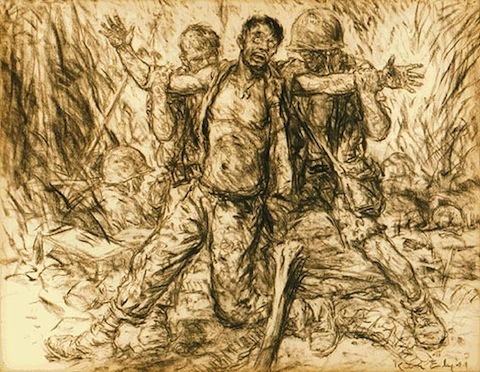
Along with the transmission methods for mass psychological illness, one of the main themes I'll be exploring in my next book is how traumatized Vietnam veterans coped with their homecomings. As such, I've been digging into the history of post-traumatic stress disorder, particularly the ways in which the condition was glossed over by the medical establishment after World War II. Though there's a good argument to be made that certain aspects of the Vietnam conflict made PTSD unusually pervasive—the evidence for which I'll be exploring in future posts—it's folly to assume that hundreds of thousands of World War II vets were never able to reintegrate into American society because of what they'd endured.
One of the threads I'm following is how the media representations of combat affected those depicted, not just the non-fighting folks on the homefront. We all know that the televised images of Vietnam's carnage helped fuel the American protest movement, but how did this new form of documentation change how vets perceived themselves? That line of inquiry has naturally led me to examine the popular images from World War II, many of which were created by artists' hands rather than photographers or filmmakers. I've previously covered various pen-and-paper chroniclers of era's military exploits, such as the cartoonist behind Corporal Gee Eye and illustrators who chronicled America's H-bomb tests. Now I've gotten turned onto the haunting work of Kerr Erby, who accompanied the Marines to Bougainville and drew some of the war's most lasting images of human suffering. The one above has stuck with me for days now: it's entitled "War is Hell (Shell Shock)," which really tells you all you need to know.
Third-party images play such a fundmental role in shaping our memories, especially as we age. I have to think that World War II vets remembered things different than their counterparts in Vietnam, solely because of the aesthetics of the conflict's artifacts.
Even if you don't agree with that assessment, I highly recommend that you check out Erby's work. And peruse a couple of Robert Benny naval paintings while you're over there.
August 10, 2011
The Utter Mess in New Caledonia
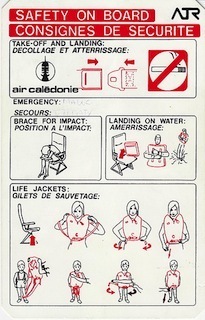 British Prime Minister David Cameron can take some small measure of solace in the fact that his government is the only one in Europe to be vexed by violent protestors. His French counterparts are suffering through similar civil unrest, though with an asterisk: the nation's pocket of trouble is located several thousand miles away from Paris, in the overseas department of New Caledonia.
British Prime Minister David Cameron can take some small measure of solace in the fact that his government is the only one in Europe to be vexed by violent protestors. His French counterparts are suffering through similar civil unrest, though with an asterisk: the nation's pocket of trouble is located several thousand miles away from Paris, in the overseas department of New Caledonia.
For those who aren't entirely up-to-date on their Melanesian politics, New Caledonia's airport is currently being blockaded by protestors who object to a recent increase in the Air Caledonie's airfares—a huge deal in a place so isolated from the outside world. The situation has gotten bad enough that the French minister in charge of the country's overseas departments has returned to Paris from her August holiday—no mean gesture in a nation where end-of-summer vacations are generally considered sacred.
There is, alas, absolutely nothing surprising about the situation in New Caledonia, a place that—like a certain AA+ superpower—suffers from total political dysfunction rooted in ideological inflexibility. I actually meant to post about this topic two months ago, when the New Caledonia narrowly averted its fifth government collapse of 2011. Since then, of course, the gridlock between Left and Right has only grown worse—and for the most idiotic of reasons:
The French supreme court has annulled last April's election of New Caledonia's Congress president, Roch Wamytan.
The court in Paris upheld a complaint by the Caledonia Together Party leader Philippe Gomes, who claimed that the process of choosing Mr Wamytan was in breach of the rules.
In a sitting which two parties boycotted after deeming it to be illegal, Mr Wamytan was chosen by 32 of the 35 members present.
A majority, however, decided to ignore the official closure of the session by the Congress vice-president and proceeded with Mr Wamytan's election.
Mr Gomes and his supporters had left the sitting after bringing down the collegial government for a third time in four weeks amid a yet unresolved dispute over which flag the territory should adopt as part of its decolonisation process.
Do I hear echoes of the whole shape-of-the-table fiasco from the negotiations to end the Vietnam War?
(Image via this exhaustive collection of airline safety cards)
August 9, 2011
The Maya Moore of Fish Cutting
 I'm rarely impressed by the talent portions of beauty pageants. Yes, I realize that baton twirling went out with leaded gasoline, but the mediocre singing and dancing that are now commonplace in such contests have done nothing to convince me that budding artists eschew the pageant circuit.
I'm rarely impressed by the talent portions of beauty pageants. Yes, I realize that baton twirling went out with leaded gasoline, but the mediocre singing and dancing that are now commonplace in such contests have done nothing to convince me that budding artists eschew the pageant circuit.
But just when I'm nearly secure in my bias, along comes Marjorie Tahbone to destroy my preconceptions. The reigning Miss Indian World wowed the judges at this spring's contest by demonstrating the entire range of Eskimo-Indian Olympic games—a far, far cooler talent than reeling off yet another sappy rendition of "The Wind Beneath My Wings."
Yet Tahbone wasn't just doing a demo—she is a tremendously badass athlete, something she proved at last month's annual World Eskimo-Indian Olympics in Fairbanks, Alaska. Tahbone took gold in four separate events, totally annihilating the field in both fish cutting and the greased pole walk. She thus earned the title of Howard Rock Outstanding Athlete, which I consider a much greater achievement than her beauty pageant crown.
A photographic tour of this year's WEIO Games here. And more shots of Tahbone here.
Previously from Microkhan's WEIO coverage: the agonizing secrets of Drop the Bomb.
August 8, 2011
Transition Game
One step forward, two steps back with the book project, alas—try as I might, can't quite seem to make the first-chapter transition from my opening scene to the requisite view-from-30,000-feet riff. Dedicating all of today to hammering my way through the wall, no matter how many thousands of useless words have to get deleted in the process. Wish me luck.
August 5, 2011
More Than Words Can Say
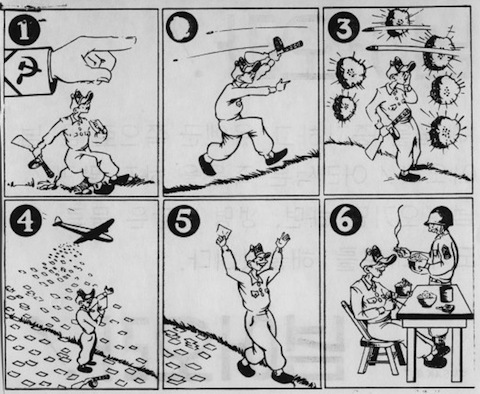
Back in 2009, I meditated upon the question of whether or not wartime propaganda leaflets are actually effective at weakening an enemy's resolve or ability to flight. The main takeaway was that design really mattered, as only certain kinds of leaflets—those with clear messages that eschewed graphic imagery—made a real impact on recipients.
Ever since writing that post, I've been interested in the nuances of propaganda leaflet design. So imagine my joy upon discovering this stupendous collection of leaflets from the Korean War. My favorite of the lot is depicted above, an appeal for North Korean soldiers to lay down their arms and enjoy a nice, hot meal provided by the decent folks at the United Nations. A bigwig from the Psychological Warfare Division, Albert G. Brauer, explains the simple rationale behind the cartoonish approach:
One problem we were confronted with was how to reach the large (80 percent) illiterate target audience. This so-called "Sad Sack" leaflet, named after a popular G.I. comic character of World War II, proved to be the answer.
In this companion critique of the military's leafleting program, Brauer claims that approximately 70 percent of the materials produced by his division were wholly ineffective, primarily because they conveyed messages that couldn't be parsed by North Korean and Chinese soliders. The most common misstep? Portraying the concept of "death" in a way that didn't make sense to the intended recipients. That, and trying to convey messages that were just way too complex to get across in a single sheet of paper. A case in point was a leaflet that tried to explain that soldiers should be skeeved out by the fact that their commanders forbid them from reading foreign propaganda. Big mistake, confesses Brauer:
Intelligence reports indicated Communist officers and cadremen were continuously forbidding men to read UN leaflets. This leaflet was designed to counter this. It was considered such a good leaflet by me and others that it was not tested on POWs prior to dropping. Later a survey was conducted and to the question: What does this leaflet mean to you, a large percentage of POWs answered, "If you read leaflets your officers will punish you." Needless to say, we stopped dropping it.
Worth noting that Brauer later became a high-school government teacher. I bet his propaganda experience actually served him well in dealing with hormone-addled American teenagers.
August 4, 2011
Screentime
Just got back from a morning spent shooting a Canadian documentary about pharmaceutical marketing. I'm one the film's talking heads, on account of a 2002 piece I did for Mother Jones about the marketing of Paxil. Strange to discuss a story that I hadn't given a second thought in nearly a decade, but hopefully I didn't embarrass myself in the process. I did, however, discover (thanks to the director's off-hand comment) that I have a problem with looking excessively "forlorn" on camera. Which might explain why I got cast as "Serf #3″ in my sixth-grade class's production of St. George and the Dragon.
Rest of the day's about catching up. Back tomorrow, perhaps with a post discussing white supremacists and the foolish girls who love them. Or maybe I'll finally get around to that riff on the porcine economy in the highlands of Papua New Guinea. Time will tell.
August 3, 2011
"Liable to Abuse by Excitable Persons"
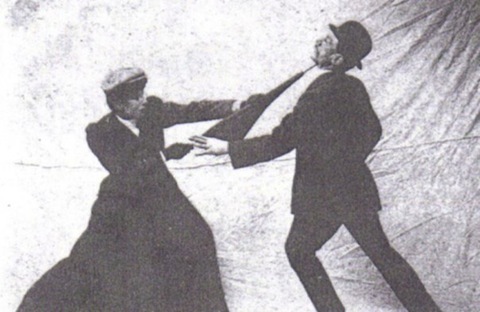
Inspired by a post delectably entitled "A Short History of Weaponised Umbrellas," I decided to delve into the existing literature on the topic. What I found was a prime example of early 20th-century prose, notable for ornate turns-of-phrase that are sorely lacking in today's self-defense manuals. Ladies and gentlemen, I give you the intelligent-yet-florid glory that is the chapter on umbrella assaults from 1911′s Broad-Sword and Single-Stick:
As a weapon of modern warfare this implement has not been given a fair place. It has, indeed, too often been spoken of with contempt and disdain, but there is no doubt that, even in the hands of a strong and angry old woman, a gamp of solid proportions may be the cause of much damage to an adversary. Has not an umbrella, opened suddenly and with a good flourish, stopped the deadly onslaught of the infuriated bull, and caused the monarch of the fields to turn tail? Has it not, when similarly brought into action, been the means of stopping a runaway horse, whose mad career might otherwise have caused many broken legs and arms?
If, then, there are these uses beyond those which the dampness of our insular climate forces upon us, it may be well to inquire how they can be brought to bear when a man, who is an expert swordsman, or one who has given attention to his fencing lessons, is attacked without anything in his hands save the homely umbrella.
It is, of course, an extremely risky operation prodding a fellow-creature in the eye with the point of an umbrella; and I once knew a man who, being attacked by many[Pg 113] roughs, and in danger of losing his life through their brutality, in a despairing effort made a desperate thrust at the face of one of his assailants. The point entered the eye and the brain, and the man fell stone dead at his feet. I would therefore only advocate the thrusting when extreme danger threatens—as a dernier resort, in fact, and when it is a case of who shall be killed, you or your assailant.
Strangely, the authors come out against the umbrella dagger, a concealed weapon much loved by martial-arts enthusiasts. They claim that the proliferation of such devices would be likely to lead to excess violence in the streets of their native London. Not an unreasonable fear, based on present evidence.
More on umbrella-fighting techniques here.
August 2, 2011
What's Yours is Mine
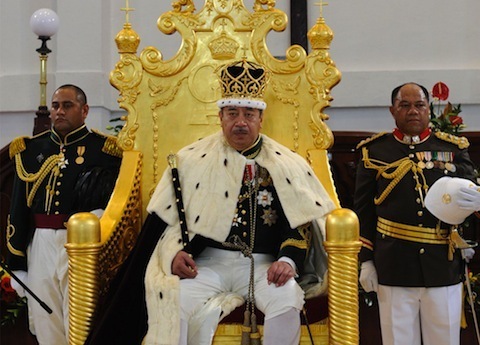
King George Tupou V of Tonga is a man accustomed to getting what he wants, regardless of his desire's impact on his people or his ability to govern. So it is somewhat heartening to learn that the monocle-wearing monarch was recently pressured into dropping plans to add another seven-figure sum to his already burgeoning coffers:
The once-impressive Tongan royal residence in Auckland will be stuck in time after protesters successfully stopped moves by the King to sell it.
A New Zealand-based group opposed King George Tupou V's plans to put the property – known as 'Atalanga and valued at about $9 million – up for sale. They have been campaigning against the sale for about a year.
King George, known for his extravagant lifestyle, rarely visits Auckland and does not stay at the Epsom residence, preferring upmarket hotels when in town.
The dispute began because the group believed the property was not the King's to sell as it had been bought with state money.
However, the King claimed that it was bought with the royal family's own private funds and did indeed belong to him personally.
The last line there gets at the essence of what bugs me most about monarchies: even in constitutional settings, there is an absurd conflation between private and public wealth. Does the king honestly believe his family somehow earned that Auckland mansion due to its hard work? And beyond that, can he really expect to have it both ways—to bill his opulent habits to the Tongan treasury, but then to claim certain possessions are personal property when it suits him? He is surely not the only modern monarch who has attempted such slight of hand, thereby strengthening the (small-r) republican case.
For more on King George's lavish spending, I suggest this 2006 piece. Terrific lede:
As the classic London taxi chauffeuring Tonga's new King sweeps through ornate gates and turns left towards the shabbiness of Nuku'alofa, a small boy squats nearby in the roadside dust and heat, hoping to sell tendrils of slimy octopus.
The boy is too busy fanning flies with a scrappy palm leaf to notice the shiny black cab or its passenger, His Majesty King George Tupou V, reclining on cream leather upholstery behind partially drawn curtains. It is the closest the boy is likely to get to the new monarch, renowned in Tonga as much for his distance from commoners as his eccentricities and odd behaviour.
Granted, anyone who rides through squalor in a limousine makes for an easy target. But King George gives his critics additional fodder by insisting on that dang top hat.
(Image of King George's 200 coronation via The Big Picture)
August 1, 2011
Leisure Defines the Man

Coming off a hugely frustrating weekend of writing, in which I ended up deleting hundreds upon hundreds of words that seemed cold and lifeless upon the screen. After much thought and a few of these, I figured out a big part of my problem: In an effort to make the story more vivid, I was layering on minor details that coalesced into one huge confusing mess. That, of course, is not the master's approach—quality beats quantity when it comes to narrative details. 'Tis better to have a single, booming anecdote than lots of ancillary descriptions that are thrown against the wall in the hopes that they'll unify into something worthwhile.
A great example of the master's approach is a detail used by Mark Bowden in Killing Pablo. Whenever I mention this book to folks seeking non-fiction recommendations, I invariably bring up this passage, which does a better job of conveying Escobar's complex combination of lunacy, malice, and megalomania than articles that have droned on for thousands of words:
To entertain his closest friends, Pablo would hire a gaggle of beauty queens for evenings of erotic games. The women would strip and race naked toward an expensive sports car, which the winner would keep, or submit to bizarre humiliations – shaving their heads, swallowing insects, or engaging in naked tree-climbing contests.
It isn't just the strange abuse of power that gets to me here; it's the creativity of Escobar's sadism, the way in which he took such great pleasure in seeing Colombia's paragons of beauty laid low. A reporter less enterprising than Bowden could surely have dredged up some anecdotes about prostitutes or strippers, the standard vices of the fabulously wealthy and amoral. But beauty queens forced to climb trees while naked? Say no more—I get where this Escobar cat is coming from, and I fear for the safety of anyone who crosses his path.
(Image via Colectiva)
July 29, 2011
Spirited Away
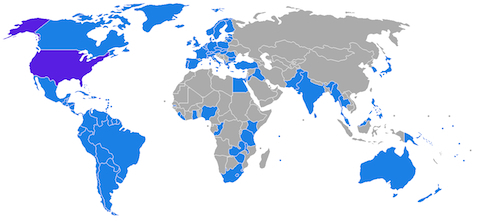
One of the most interesting aspects of researching my slot-machines yarn for Wired was the whole extradition angle. In fact, I'd daresay that's what attracted me to the story in the first place—the fact that the United States government deemed the crime grave enough to go an fetch someone from Latvia, a country that had never before shipped one of its own into the maw of America's judicial system. There were obviously some deep political considerations at work here, as well as a strong desire to send a message to Latvia's criminal subculture. I'm sure it's no coincidence that the raid on Rodolfo Rodriguez-Cabrera's business took place, quite literally, mere hours after the signing of the first post-Soviet extradition treaty between Latvia and the U.S.
Since tackling the Wired project, I've taken a keen interest in extradition cases, especially those in which a serious crime in one country is nothing more than a misdemeanor in another. A perfect example is the ongoing case of Brian and Kerry Ann Howes, a Scottish couple who once ran a chemical supply company. The U.S. government alleges that they sold red phosphorous and iodine to many methamphetamine manufacturers on these shores, and it now looks like the Howes will be extradited to Arizona to stand trial:
Brian and Kerry Ann Howes, from Bo'ness, near Falkirk, are said to have sold legal chemicals which were then used to make illegal drugs in the US. The pair maintain they ran a legitimate business and have been fighting extradition for more than four years.
The pair were arrested by Central Scotland Police in 2007, amid claims they supplied more than 40 chemicals to dealers via the online company Lab Chemicals International. The charges against Mr and Mrs Howes allege they used their internet company to supply red phosphorous and iodine to 400 customers in the US, most of whom were producing methamphetamine, also known as crystal meth.
Red phosphorous and iodine are legal in Britain, but regulated in the US.
The case falls under the 2003 Extradition Act which allows the extradition of people to the US without any trial taking place in the UK, removing the need for US authorities to provide prima facie evidence of criminality…The allegations include deliberately mislabeling chemicals sent to the US in a bid to avoid detection.
To understand the case, it's essential to read the American indictment, which contains specific details regarding the Howes' alleged efforts to avoid detection. One major complicating factor is that the Howes initially responded in the legally correct way when confronted by an undercover DEA agent claiming to be running a meth lab: they cancelled his order. (When asked to ship to the same address some time later, however, the Howes complied.)
Based on my experiences reporting the Wired piece, I do think it's impossible to make blanket statements about when extradition is appropriate and when it isn't. Furthermore, if the information in the Howes indictment is correct, I think it's safe to say they had a pretty good idea of how their wares were being used Stateside. Yet the fact remains that they were operating within the confines of British law. Wouldn't American legal resources be better served trying to mend that discrepancy, rather than focusing on a single case that will do nothing to clear up the ambiguity on the books?
(Map above shows nations with which the U.S. has extradition treaties)




